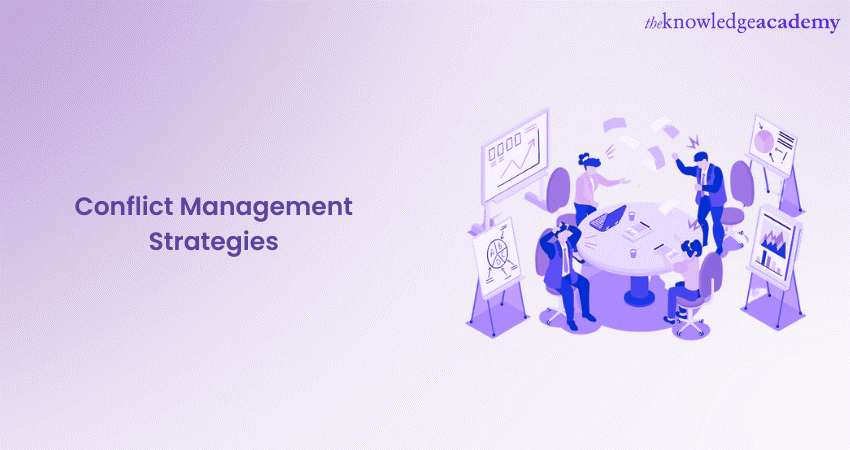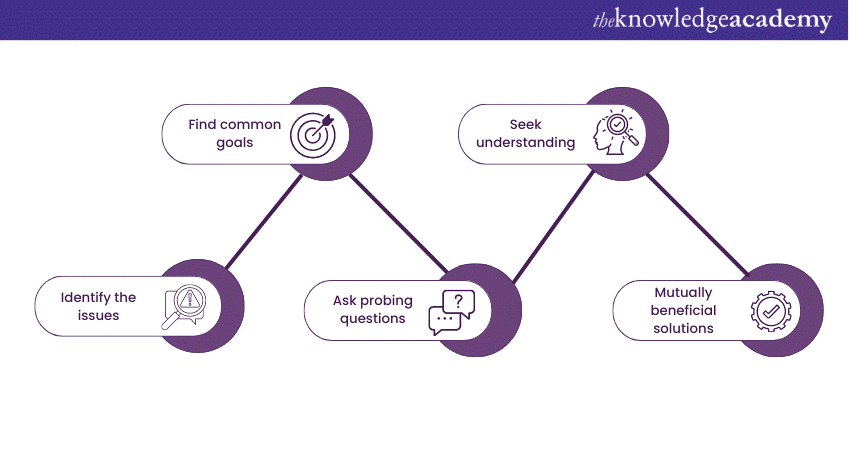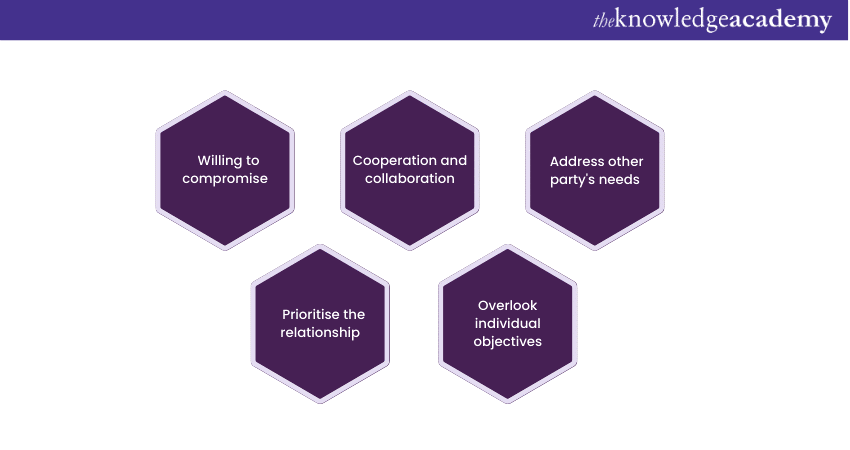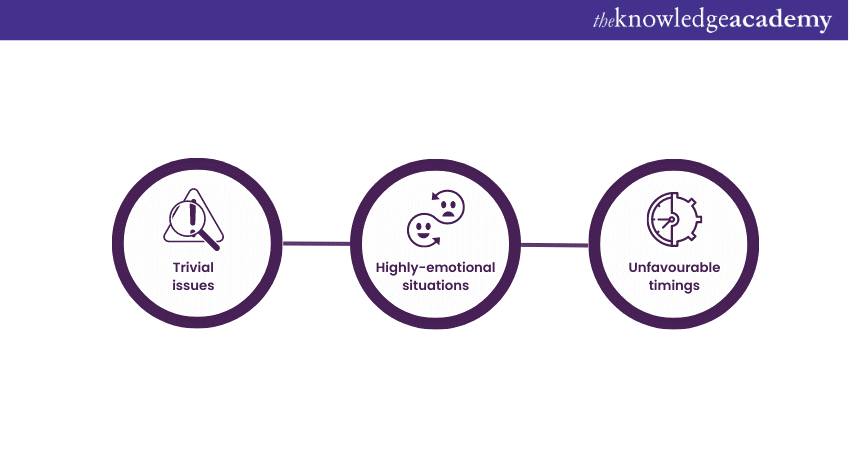We may not have the course you’re looking for. If you enquire or give us a call on 01344203999 and speak to our training experts, we may still be able to help with your training requirements.
Training Outcomes Within Your Budget!
We ensure quality, budget-alignment, and timely delivery by our expert instructors.

Conflicts can disrupt harmony, hinder productivity, and strain relationships. This is where employing various Conflict Management Strategies becomes crucial. These strategies are tools for navigating conflicts and achieving positive resolutions.
They help in managing conflicts, fostering understanding, and effective conflict resolution. So, learning how to manage conflicts becomes crucial to achieving harmony and success. In this blog, you will learn about the top five Conflict Management Strategies and learn how employing these strategies can foster collaboration. Let's dive in deeper to learn more!
Table of contents
1) Strategies for managing conflicts
a) Collaborative Problem-solving
b) Compromising for Mutual Gain
c) Accommodating and Yielding
d) Competing and Assertiveness
e) Avoiding Conflict
2) Conclusion
Strategies for managing conflicts
Conflict Management Strategies are diverse techniques individuals and organisations can employ to handle conflicts and promote productivity effectively. So, let's explore what 5 Conflict Management Strategies are:
1) Collaborative Problem-solving
Collaborative Problem-solving is a highly effective Conflict Management technique emphasising cooperation and active communication among all parties involved. This technique promotes a collaborative approach to finding solutions. Moreover, it allows a more inclusive and comprehensive resolution process. Let's explore the key aspects of Collaborative Problem-solving:
a) Open dialogue and active listening:
Collaborative Problem-solving begins with creating an environment that encourages open dialogue. Everyone involved should feel comfortable expressing their perspectives, concerns, and ideas.
Further, active listening plays a crucial role in this technique. It involves giving undivided attention to others, seeking to understand their viewpoints. It also includes asking questions when necessary.
By actively listening, participants can better understand each other's needs and perspectives. As a result, it fosters empathy and promotes a sense of mutual respect.

b) Identifying underlying issues:
Collaborative Problem-solving also involves delving beneath the surface-level conflict to identify the underlying issues at play. This requires asking probing questions and actively seeking to understand the primary causes of the conflict.

Participants should strive to identify shared interests and common goals amidst conflicting positions. By focusing on these shared elements, they can work together towards a resolution that benefits all parties involved.
c) Brainstorming creative solutions:
Once the underlying conflict issues have been identified, Collaborative Problem-solving encourages brainstorming a wide range of potential solutions. This opens the door for creativity and innovation. Further, it helps in finding mutually agreeable outcomes for resolving the conflict.
During the brainstorming phase, all ideas should be welcomed and recorded without judgment. This encourages a free flow of ideas and prevents premature dismissal of potentially valuable solutions.
Participants can use strategies such as mind mapping, listing pros and cons, or conducting group discussions to produce a diverse set of potential solutions.
d) Evaluation and consensus building:
Collaborative Problem-solving involves evaluating each option based on its feasibility, effectiveness, and alignment with the parties' goals.
Participants should discuss the advantages and disadvantages of each solution and consider the potential impact on all stakeholders involved. Through open and transparent discussions, parties can work towards consensus. This helps them seek a solution that satisfies the core needs and interests of all involved.
e) Implementing and monitoring the solution:
Once a consensus has been reached, Collaborative Problem-solving requires a commitment to implementing the agreed-upon solution. Clear action steps and responsibilities should be established to ensure effective execution.
Collaborative Problem-solving offers a powerful framework for resolving conflicts. At the same time, it helps foster cooperation, understanding and creative problem-solving.
Master the art of problem-solving and become a catalyst for innovation with our Problem-Solving Training – Sign up now!
2) Compromising for Mutual Gain
Compromising for Mutual Gain is a Conflict Management Technique that involves finding a middle ground. Here, all parties involved make concessions to reach a resolution that partially satisfies their respective needs. This technique recognises the importance of collaboration and shared outcomes. Let's explore the key aspects of compromising for mutual gain:
a) Understanding shared interests:
Compromising starts with recognising and understanding the shared interests among the conflicting parties. Identifying these common goals and desired outcomes forms the basis for finding a mutually beneficial resolution.
By acknowledging shared interests, parties can establish a foundation of collaboration and cooperation. As a result, they can pave the way for productive compromise.
b) Flexibility and adaptability:
Compromising requires a willingness to be flexible and adaptable. It involves considering alternative perspectives and being open to adjusting one's own position.
Parties involved should be willing to let go of rigid stances and explore possibilities. Flexibility allows for the exploration of creative solutions that satisfy the core needs of all parties.
c) Negotiation and trade-offs:
Negotiation plays a central role in Compromising for Mutual Gain. It involves a give-and-take approach, where parties exchange concessions to achieve a balanced outcome.
Parties should engage in constructive discussions, articulating their needs and concerns and seeking common ground. Negotiation requires effective communication and active listening to reach mutually agreeable terms.
Trade-offs are also inherent in compromising. Each party may need to sacrifice certain aspects of their initial position in order to reach a resolution that is acceptable to all. This requires a fair and balanced approach to ensure that concessions are distributed equitably.
d) Time sensitivity:
Compromising can be a useful technique when time is limited, and a quick resolution is required. The ability to reach a compromise efficiently can prevent prolonged conflicts and allow parties to move forward.
However, it is important to strike a balance between the urgency of reaching a resolution. It is also important to consider the needs and interests of all parties. Rushing the compromise process may lead to unsatisfactory outcomes.
e) Preserving relationships:
Compromising for Mutual gain Recognises the importance of maintaining positive relationships. The focus is not solely on achieving individual goals but also on nurturing collaborative and harmonious interactions. By valuing the relationships at stake, parties can achieve the following:
1) Foster trust
2) Respect
3) Goodwill
Moreover, compromising can contribute to building stronger relationships and establishing a foundation for future cooperation. It just requires a constructive and collaborative approach to conflict resolution. As a result, conflicts can be transformed into opportunities for mutual gain, fostering cooperation and long-term harmony.
Harness the power of effective conflict management and transform challenges into opportunities with our Conflict Management Training – Sign up now!
3) Accommodating and Yielding
Accommodating and Yielding is a Conflict Management technique where one party prioritises the needs and concerns of the other over their own. This approach aims to foster harmony, maintain relationships and preserve goodwill. Let's explore the key aspects of Accommodating and Yielding:
a) Maintaining relationships:
Accommodating and Yielding recognises the significance of preserving relationships. It is particularly helpful in situations where long-term partnerships or personal connections are valued.
This technique involves considering the impact of the conflict on the relationship, it also places importance on maintaining positive interactions and cooperation.
b) Showing understanding and empathy:
Accommodating requires showing understanding and empathy towards the other party's perspective, needs, and concerns. It involves actively listening and acknowledging their viewpoints without dismissing them.
By demonstrating understanding, parties can foster an environment of trust and respect. This can contribute to a more constructive conflict resolution.
c) Finding common ground:
Accommodating also involves seeking common ground and identifying areas where agreement can be reached. It focuses on shared interests and goals rather than solely on individual positions.
Parties should explore areas of agreement and leverage those to find mutually beneficial solutions that address the core needs of both parties.
d) Making concessions:
Yielding requires making concessions to accommodate the other party's needs and concerns. It involves prioritising the relationship or the greater good over individual objectives. It is an extremely useful Conflict Management Strategies example that you can implement to resolve a conflict.

Parties should be willing to make sacrifices and compromises in areas that are less critical to their core interests. This helps demonstrate a spirit of cooperation and collaboration.
e) Setting boundaries:
While accommodating, it is important to establish boundaries and communicate one's own needs and limitations. Parties should clearly express what they can and cannot accommodate. This helps ensure that their own well-being is not compromised entirely.
Further, open and honest communication about personal boundaries helps maintain a balance between accommodating and asserting individual needs.
f) Long-term considerations:
Accommodating and Yielding should be employed in situations where preserving relationships or long-term partnerships is more important than immediate personal objectives. It is valuable Conflict Management Strategies when the preservation of relationships is a priority.
Parties should consider the potential impact of their actions on future interactions. They should also evaluate whether accommodating is a sustainable approach in the given context.
This can contribute to maintaining positive relationships, fostering cooperation, and preserving harmony.
Unleash your leadership potential and learn the art of managing people with finesse. Join our Introduction To Managing People Course now!
4) Competing and Assertiveness
Competing and Assertiveness is one of the important Conflict Management Techniques where one party pursues their goals and interests without considering the needs of others. This technique involves standing firm, advocating for one's position, and asserting dominance. Let's explore the key aspects of Competing and Assertiveness for managing conflicts:
a) Advocating for one's position:
Competing and Assertiveness require clearly articulating one's own goals, needs, and perspectives. It involves expressing oneself confidently and advocating for one's position without hesitation. By clearly stating one's objectives, parties can ensure that their viewpoints are heard and considered during the conflict resolution process.
b) Standing firm:
Competing involves maintaining a firm stance and not easily giving in to opposing views or pressures. It requires being resolute in pursuing one's own interests and objectives. This technique can be appropriate in situations that require quick decision-making or when it is necessary to protect important principles.
c) Asserting dominance:
Assertiveness is a key component of competing. It involves asserting one's dominance and influencing the outcome of the conflict. Assertive individuals should share their viewpoints firmly, confidently, and without aggression or intimidation. They must communicate their expectations clearly and expect their needs to be acknowledged.
d) Balancing collaboration and assertiveness:
While competing focuses on individual goals, it is important to strike a balance between assertiveness and collaboration. Collaboration may be necessary in situations where long-term relationships or collective goals are at stake.
At the same time, competing should be used judiciously and in situations where it is crucial to assert one's position. However, overusing this technique may strain relationships and hinder collaboration.
e) Quick decision-making:
Competing can be useful in situations that require swift decision-making, especially when time is limited. It allows for expedited resolution by emphasising the need for efficiency and prompt action.
However, it is essential to consider the potential consequences of making quick decisions without fully exploring alternative perspectives or considering the interests of others.
f) Importance of respect:
While competing, it is important to maintain a level of respect for the other party's opinions and viewpoints. Respectful communication helps keep the lines of dialogue open. It also fosters an environment for constructive resolution.
g) Selecting appropriate contexts:
Competing and Assertiveness may be more suitable in situations where a clear hierarchy is established. It is also fit for competitive environments where achieving personal objectives is prioritised.
However, it is crucial to assess whether competing is the most effective technique for the given context. Also, consider its impact on relationships, long-term goals, and the potential for collaboration.
Competing and Assertiveness can be effective Conflict Management Strategies, however, it is important to keep the following criteria in mind:
1) Exercise these strategies judiciously
2) Strike a balance between collaboration and assertiveness
3) Consider the potential consequences on relationships and long-term objectives
By being assertive and confident while maintaining respect for others, individuals can navigate conflicts in a manner that upholds their own interests and values.
5) Avoiding Conflict
Avoiding Conflict is one of the most effective strategies in Conflict Management. This approach is suitable in the following situations:

1) When the issue at hand is trivial
2) Emotions are running high
3) The timing isn't appropriate for addressing the conflict
It involves evading or postponing the resolution of a conflict. Let's explore the key aspects of avoiding conflict:
a) Recognising trivial issues:
Avoiding Conflict is appropriate when the conflict at hand is relatively minor or inconsequential. It involves considering whether the issue truly warrants immediate attention or if it can be overlooked without significant consequences.
By recognising trivial issues, parties can prioritise their energy and efforts on more important matters. This helps prevent unnecessary conflicts from arising.
b) Emotional considerations:
Emotions play a significant role in conflicts. There may be situations when emotions are running high, hindering effective communication and problem-solving.
Temporarily avoiding conflict can provide time for emotions to subside. This allows a more rational and level-headed approach to resolving the conflict in the future.
c) Timing and context:
Timing is crucial when it comes to conflict resolution. Avoiding conflict may be appropriate when the timing isn't conducive to addressing the issue or when addressing it would be counterproductive or disruptive.
In such cases, parties may choose to postpone conflict resolution until a more suitable time, such as when all parties are calmer and more receptive or when there is a more appropriate setting for discussions.
d) Long-term considerations:
Although, temporarily avoiding conflicts can be feasible, avoiding conflicts should not be used as a long-term strategy. Unresolved conflicts can fester and lead to negative consequences such as resentment, decreased productivity, or damaged relationships.
Parties should be mindful of the potential long-term implications of avoiding conflict. They should make a conscious effort to address conflicts when they are more manageable.
f) Open communication:
While avoiding conflict, it is important to maintain open lines of communication with the other party. This allows future discussions and ensures that the conflict is not completely disregarded.
Communicating the intention at a later time demonstrates a willingness to engage in a constructive resolution process. It is particularly important when the circumstances are more favourable.
f) Strategic decision-making:
Avoiding conflict can be a strategic decision when the potential benefits of addressing the conflict do not outweigh the potential risks. Before deciding to postpone conflict resolution, you need to carefully consider the following:
1) The impact on relationships
2) Personal well-being
3) Broader organisational goals
While avoiding conflict may be appropriate in certain situations, it is essential to recognise when the conflict needs to be addressed. Parties should be vigilant in monitoring the conflict to ensure that it does not escalate or become a long-standing issue. By addressing conflicts in a timely manner, you can foster healthy communication, maintain positive relationships, and prevent unresolved conflicts.
Conclusion
We hope that you have read and understood everything Conflict Management Strategies. These strategies offer diverse tools for resolving conflicts. By employing collaborative problem-solving, compromising, accommodating, competing, or avoiding conflict, individuals and organisations can foster positive resolutions. They can also maintain harmonious relationships.
Unlock your leadership potential and excel in managing conflicts with our comprehensive Management Training Courses – Sign up today!
Frequently Asked Questions
Upcoming Business Skills Resources Batches & Dates
Date
 Conflict Management Training
Conflict Management Training
Fri 19th Jul 2024
Fri 20th Sep 2024
Fri 1st Nov 2024







 Top Rated Course
Top Rated Course


 If you wish to make any changes to your course, please
If you wish to make any changes to your course, please


